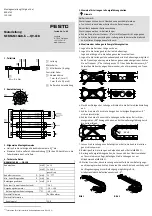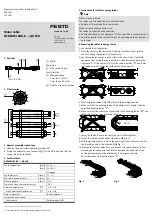
Assembly instructions (original: de)
8004745
1301NH
†‡
Motor cable
NEBM-M16G8-E-...-Q9-LE8
Festo AG & Co. KG
P.O. box
73726 Esslingen, Germany
+49 711 347-0
www.festo.com
1.
Parts list
18366d_1
1
Cable
Motor side:
2
M16 socket (8-pin)
Controller side:
3
Wire end sleeve
7 mm (4x 1.5 mm²)
7 mm (2x 2x 0.5 mm²)
4
Outside
screen
connection
2.
Pin allocation
18366d_2
18367d_3
1
3.
General assembly instructions
Observe the permissible tightening torques M
A
1)
.
Clamp the external screen connection
4
for the PE connection into the
spring clip of the controller.
4.
Technical data
NEBM-M16G8-E-...-Q9-LE8
Cable composition
[mm²]
4x 1.5
[mm²]
2x 2x 0.5
screened
Cable diameter
D
[mm]
12
+0.80
−
0.75
Min. cable bending radius
R
[mm]
64
Mounting space
A
[mm]
240
Protection class (in mounted status)
IP 65
Ambient temperature
[°C]
−
50
…
+90
With flexible cable installation
[°C]
−
40
…
+90
Note on materials
RoHS-compliant
Information on materials
Cable
sheath
Polyurethane
(PUR)
1)
Tolerances for non-toleranced tightening torques M
A
± 20%
5.
Instructions for cables in energy chains
Note
If there is a chain break:
The cables can be damaged due to overstretching.
Replace all the cables after a chain break.
With a vertically hanging chain array:
The cables will stretch during operation.
Ensure that there is more clearance “X” than specified in assembly step 3.
Check the length of the cables after a short operating period and adjust, if
necessary.
6.
Mounting the cables in energy chains
1.
Lay the chain out lengthwise.
2.
Place the cables in the chain studs, making sure they are not twisted.
Lay out or hang the cables first, if necessary.
3.
Lay the cables loose next to each other in the chain studs, if possible
separated from each other by separators or separate holes. Ensure the
clearance “X” of the cables is 10% of the cable diameter “D”. Avoid plac-
ing cables on top of each other without use of separators.
7435d_3
4.
After laying the cables, adjust the chain in the working position.
5.
Make sure that the bending radius of the cables is not smaller than the
permitted bending radius “R”.
6.
Make sure that the cables can move freely in the bending radius “KR”; the
cables must not be forced through the chain.
7435d_4
7.
Leave the cables loose in the chain; do not tie them together.
8.
Fasten the cables at both ends of the chain (
Fig. 1).
9.
With long energy chains in which the upper run lies on the lower run, fas-
ten the cables only at the driver end (
Fig. 2).
10.
Make sure that the cables are on no account moved all the way to the
fastening point. Make sure the distance between the end point of the
bending movement and the attachment is as large as possible
but at least equal to mounting space “A”.
Fig. 1
7435d_2
Fig. 2
7435d_1
M
A
= 0.4 Nm
1
3
2
2
4
2
KR
›
R




















